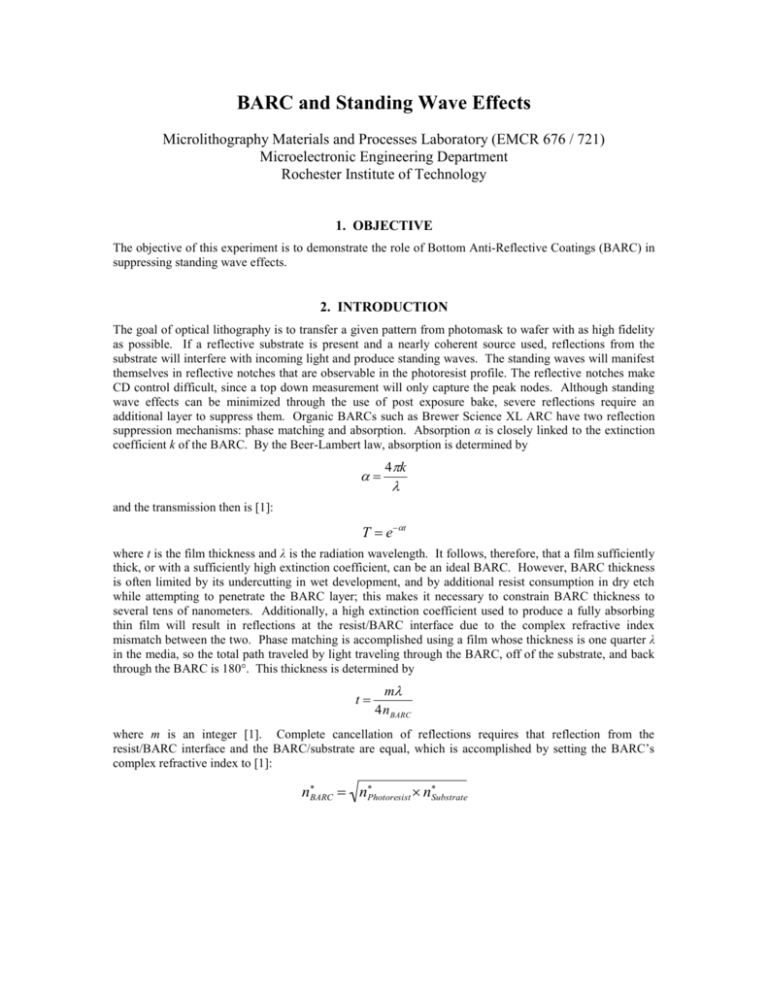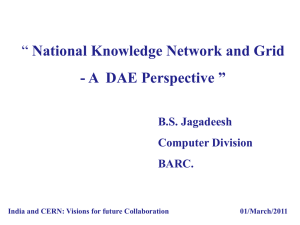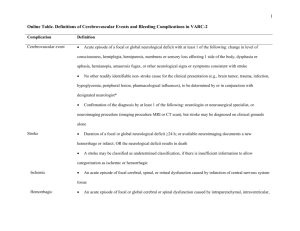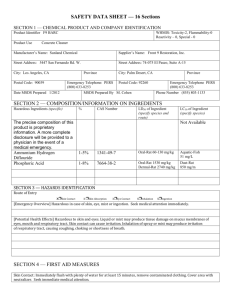BARC and Standing Wave Effects Laboratory - People
advertisement

BARC and Standing Wave Effects Microlithography Materials and Processes Laboratory (EMCR 676 / 721) Microelectronic Engineering Department Rochester Institute of Technology 1. OBJECTIVE The objective of this experiment is to demonstrate the role of Bottom Anti-Reflective Coatings (BARC) in suppressing standing wave effects. 2. INTRODUCTION The goal of optical lithography is to transfer a given pattern from photomask to wafer with as high fidelity as possible. If a reflective substrate is present and a nearly coherent source used, reflections from the substrate will interfere with incoming light and produce standing waves. The standing waves will manifest themselves in reflective notches that are observable in the photoresist profile. The reflective notches make CD control difficult, since a top down measurement will only capture the peak nodes. Although standing wave effects can be minimized through the use of post exposure bake, severe reflections require an additional layer to suppress them. Organic BARCs such as Brewer Science XL ARC have two reflection suppression mechanisms: phase matching and absorption. Absorption α is closely linked to the extinction coefficient k of the BARC. By the Beer-Lambert law, absorption is determined by 4k and the transmission then is [1]: T e t where t is the film thickness and λ is the radiation wavelength. It follows, therefore, that a film sufficiently thick, or with a sufficiently high extinction coefficient, can be an ideal BARC. However, BARC thickness is often limited by its undercutting in wet development, and by additional resist consumption in dry etch layer; this makes it necessary to constrain BARC thickness to while attempting to penetrate the BARC several tens of nanometers. Additionally, a high extinction coefficient used to produce a fully absorbing thin film will result in reflections at the resist/BARC interface due to the complex refractive index mismatch between the two. Phase matching is accomplished using a film whose thickness is one quarter λ in the media, so the total path traveled by light traveling through the BARC, off of the substrate, and back through the BARC is 180°. This thickness is determined by t m 4nBARC where m is an integer [1]. Complete cancellation of reflections requires that reflection from the resist/BARC interface and the BARC/substrate are equal, which is accomplished by setting the BARC’s complex refractive index to [1]: nBARC nPhotoresist nSubstrate 3. PROCEDURE The goal of this lab is to investigate the benefits of an ARC layer. In order to do this, we will create a standing wave condition in the resist image. Recall that one advantage of a post-exposure bake in resist processing is reduction in standing wave effect through thermal flow. We will therefore remove the postexposure bake from our resist processing, creating a visible standing wave effect, and then use BARC to minimize this standing wave by reducing substrate reflection. Choose a procedure that will illustrate the existence of standing waves, and conduct the experiment with and without a BARC layer. Consult the procedures of the previous laboratories for inspiration. 3.1 PROLITH simulation 1) Using PROLITH, modify the default simulation in the following way: a) Film Stack i) Select the photoresist your group will be using with a thickness similar to what we achieve in the SMFL. b) Imaging Tool i) Verify that the illumination wavelength is either 365nm (i-line) or 436nm (g-line), depending on which stepper your group will be using. ii) Verify Conventional illumination-partial coherent is selected iii) Verify partial coherence is set to 0.6 for the Canon FPA 2000-i1 or 0.68 for the GCA 6700. iv) Verify NA set to 0.52 for the Canon FPA 2000-i1 or 0.28 for the GCA 6700. c) Post Exposure Bake i) Set PEB time to 2.0 seconds (if set to 0, exposure profiles are not very good, and this gives us the right conditions we’re after) 2) Examine the diagram obtained in the resist profile window demonstrating the reflective notching 3) Using an available BARC (probably Brewer XLT), perform simulation sets varying ARC thickness and examine plots of substrate reflectance vs. ARC thickness; use this plot to find the optimum BARC thickness. 4) Also examine the resist profile diagram for a film-stack including an optimized BARC thickness. 3.2 Baseline data 1) Depending on the chosen procedure, you may be able to reuse data collected during a previous lab; this may grant you additional time to conduct a more thorough investigation. 2) Collect baseline data using wafers coated with photoresist. 3.3 BARC Wafer 1) Repeat the procedure used to collect baseline data, but coat the wafers with BARC before coating them with photoresist. a) Refer to datasheets and presentations provided by the manufacturer for suggested procedures regarding silation (HMDS application), BARC post-coat bake temperatures and times, and spin speed curves. It is suggested that you verify the manufacturer’s spin speed curves by conducting your own. b) BARC thickness may be measured with profilometry; there may also be an applicable program in the Tencor SpectraMap. i) On the SpectraMap, it is important to place the wafer as close to the center of the chuck as possible; if the maximum point measured on the SpectraMap is an order of magnitude larger than the mean, the tool has measured off the edge of the wafer. If this happens despite your best efforts to center the wafer, either decrease the measuring diameter, or decrease the Sorting σ which dictates whether or not a point is discarded based on how many standard deviations it is away from the mean. 2) Given extra time, you may investigate additional treatment combinations, such as the inclusion of a PEB, and BARC coated at a non-optimized thickness. 4. DISCUSSION 1) Compare the results obtained in lab to the PROLITH results obtained before lab. Note any differences and the possible reasons for these differences. 2) Calculate nodal spacing, if possible, and compare those to what you would predict using theory. 3) Using the extinction coefficient for the BARC, compute the minimum thickness needed for 0 transmission. 4) Using refractive indices obtained from PROLITH and/or the RIT Lithography group website at http://www.microe.rit.edu/research/lithography/utilities.htm, compute the ideal complex refractive index of a BARC using silicon as a substrate and OiR 620 as a photoresist. 5) Using your collected data, quantify the reduction of standing waves that results from the inclusion of a BARC layer. REFERENCES 1. 2. 3. B.W. Smith and J.R. Sheats, “Microlithography: Science and Technology”, Marcel Dekker, 1998, New York. Brewer Science XL ARC Datasheet and Presentation Olin OiR 620 Datasheet




